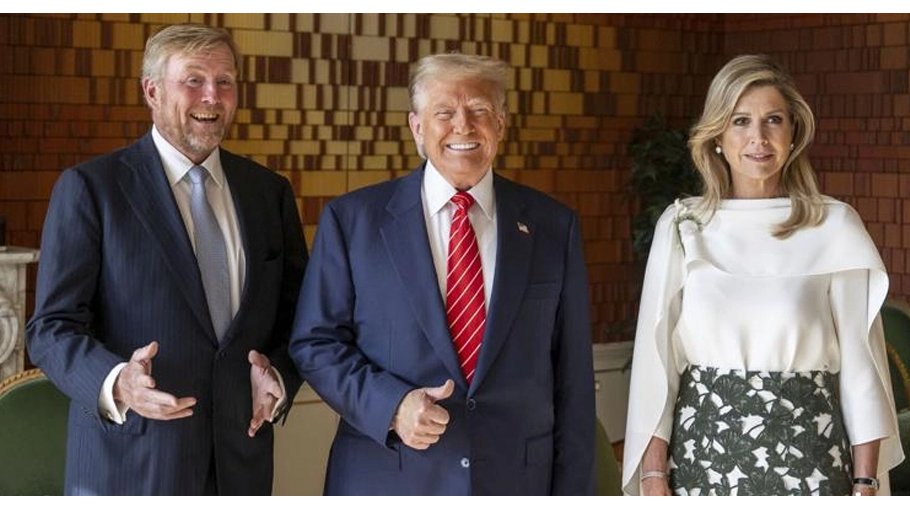NATO leaders agree to boost military spending

NATO leaders on Wednesday committed to a significant increase in defense spending following pressure from U.S. President Donald Trump while reiterating their “ironclad commitment” to defend one another if attacked.
In a joint statement, all 32 members pledged to invest 5% of their GDP annually in core defense and security-related expenditures by 2035 to fulfill both national and collective defense responsibilities.
Spain has already confirmed it will not be able to meet this target, calling it unrealistic, and several others have voiced doubts.
However, the agreement includes a review in 2029 to assess progress and reevaluate the security situation regarding Russia.
The leaders also reaffirmed NATO’s collective defense principle, stating “an attack on one is an attack on all.” The declaration came after Trump reignited uncertainty over whether the United States would stand by its allies.
Despite underlying divisions, the unified statement reflects what NATO Secretary-General Mark Rutte described as a “transformational” summit. However, the defense spending commitment places considerable financial demands on European allies and Canada.
The increased military spending comes as the United States — NATO’s largest contributor — begins to shift its focus away from Europe to other regions, notably the Middle East and Indo-Pacific.
Spain preemptively declared it would miss the 2035 goal, calling it “unreasonable.” Belgium and Slovakia have also expressed reservations, with Slovakia insisting it will determine its own defense budget independently.
Economic struggles in many European countries, combined with Trump’s global tariff policies, may make it harder for allies to meet their new military obligations. Some nations are already cutting welfare programs and foreign aid to divert more funds to defense.
On Tuesday, Trump criticized Spain for not committing to the spending targets, stating, “there’s a problem with Spain. Spain is not agreeing, which is very unfair to the rest of them, frankly.” He also took aim at Canada, calling it “a low payer.” During Trump’s first term in 2018, a NATO summit nearly collapsed over a similar defense spending dispute.
Acknowledging the financial and political challenges, Rutte admitted, “these are difficult decisions. Let’s be honest. I mean, politicians have to make choices in scarcity. And this is not easy.” But he added, “given the threat from the Russians, given the international security situation, there is no alternative.”
Nations Near Russia Lead the Push
Countries bordering Russia and Ukraine — including Poland, the Baltic States, and the Nordic nations — have pledged to meet the goal, along with major European powers like Britain, France, Germany, and the Netherlands.
“This is a big win, I think, for both President Trump and I think it’s also a big win for Europe,” said Finnish President Alexander Stubb. “We’re witnessing the birth of a new NATO, which means a more balanced NATO.”
Stubb noted that the new spending levels would mirror Cold War-era defense budgets. NATO allies began cutting military spending after the fall of the Berlin Wall in 1989, assuming a more peaceful era.
In a nod to Trump’s political slogan, Lithuanian President Gitanas Nausėda remarked, “We should choose a motto, ‘make NATO great again.’”
Following Russia’s full-scale invasion of Ukraine in 2022, NATO set 2% of GDP as the minimum defense spending target. Last year, 22 allies were expected to meet that benchmark, a sharp rise from just three nations a decade ago.
At the summit in The Hague, members endorsed an overhaul of defense spending. They raised the target for “core defense spending” to 3.5% of GDP and broadened the criteria to include military support to Ukraine.
To meet Trump’s 5% expectation, allies also committed 1.5% of GDP to other defense-related areas, such as upgrading infrastructure to support troop movements, enhancing cyber defenses, countering hybrid threats, and bolstering societal resilience to future conflicts.
Progress will be assessed in 2029, after the next U.S. presidential election.
Norwegian Prime Minister Jonas Gahr Støre described the agreement as a milestone. “This declaration is historic. We are 32 allies supporting that ambition, which is huge,” he said. “We have been struggling to get above 2% and now we said 3.5%, which is necessary in order to reach our capabilities.”
Earlier this month, NATO set procurement targets for allies to stockpile weapons and military supplies to better defend Europe, the Arctic, and the North Atlantic — a reflection of Washington’s pressure to boost defense readiness.
Uncertainty Over U.S. Troop Presence in Europe
If the Trump administration proceeds with plans to reduce the roughly 84,000 U.S. troops stationed in Europe, additional funding will be needed for European allies to cover security gaps. The Pentagon is expected to clarify its position in the coming months.
Beyond Trump's demands, European allies and Canada have already increased defense spending amid rising fears of Russian aggression. Some NATO countries believe Russia could launch an attack on alliance territory before the decade ends — Hungary, however, disagrees.
“I think Russia is not strong enough to represent a real threat to us. We are far stronger,” said Hungarian Prime Minister Viktor Orbán, who is regarded as Russian President Vladimir Putin’s closest ally in Europe, while speaking to reporters with his hands in his pockets.



